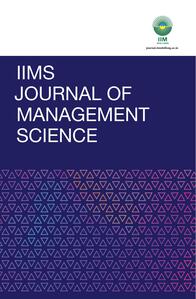
1Dr. Prema Basargekar is working as an Associate Professor at the K.J. Somaya Institute of Management Studies and Research, Mumbai in the areas of Economics and Entrepreneurship Management. She has completed her doctorate from BITS Pilani. She can be reached at prema@somaiya.edu, basargekarprema@gmail.com
The growth of micro-finance in terms of breadth and width in world as well as in India has been phenomenal. Existing research mainly focuses on its impact on empowerment of poor women through access to micro-credit by promotion of entrepreneurship, reduction in economic vulnerability, etc. One of the major contributions of microfinance is also in terms of provision of access to ‘micro-savings’ to poor women. This other side of microfinance until recently was not given due importance due to predominance given to micro-credit. Slowly it is realised that micro-savings play an equally important role in overall empowerment process of poor women. This paper aims to assess the relevance and importance of ‘micro-savings’ as one of the major tools of empowerment with special reference to India. It uses primary data analysis of 698 microfinance clients from Maharashtra state. The paper concludes that access to ‘micro-saving’ is one of the most prominent reasons for microfinance clients to join the programme and the SHG model of microfinance has resulted in building financial assets for poor women.
Micro-saving, asset building, women empowerment
JEL Classification: G21
Berg, G. (2010). Evaluating the impacts of microsaving: The case of sewa bank in India, Journal of Economic Development, Vol. 35, No. 1, pp. 75-96.
Bergsma, K. (2011). Does offering microsaving make sense for microfinance institutions? The American Economist, Vol. 56, No. 2, pp. 15-27.
Carpenter, S. and Jensen, R. (2002). Household participation in formal and informal savings mechanisms, Review of Development Economics, Vol. 6, No. 3, pp. 314-328.
CGAP Donor Brief: Savings are as important as Credit: deposit services for the Poor, (2002). http://www.cgap.org/ sites/default/files/CGAP-Donor-Brief-Savings-Are-as-Important-as-Credit-Deposit-Services-for-the-PoorJun-2002.pdf, retrieved on 2nd Nov, 2013.
Deshpande, R. (2006). Safe and Accessible: Bringing Poor Savers into the Formal Financial System, http:// www.microfinancegateway.org/p/site/m/template.rc/1.9.28097/, accessed on 25th Jan, 2013
Dowla, A. and Alamgir, D. (2003). From microcredit to microfinance: evolution of saving products by MFIs in Bangladesh, Journal of International Development, Vol. 15, No. 8, pp. 969-988.
Drolet, J. (2011). Women’s Micro Credit loans and Gam’ Iyyaat Saving Clubs in cairo, Egypt, Journal of Human Security, Vol. 7, No. 2, pp. 20-31.
Gertler, P., Levine, D. and Enrico, M. (2009). Do microfinance programmes help families insure consumption against illness? Health Economics, Vol. 18, No. 3, pp. 257-275.
Halder, S. and Mosley, P. (2004). Working with ultr-poor: Learning from BRAC experiences, Journal of International Development, Vol. 16, pp. 387-406.
Hossain, M. (2012). Measuring the impact of BRAC microfinance operations: A case study of a village, International Business Research, Vol. 5, No. 4, pp. 112-123.
Hulme, D., Moore, K. and Barrientos, A. (2009). Assessing the insurance role of microsavings, DESA working Paper No 83.
Introducing savings in Microcredit institutions: when & how, CGPA focus Note (1997). http://www.cgap.org/ sites/default/files/CGAP-Focus-Note-Introducing-Savings-in-Microcredit-Institutions-When-and-HowApr-1997.pdf accessed on 3rd February, 2013.
Kropp, E. and Suran, B. (2002). Linking Banks and (Financial) SHGs in India: An Assessment paper presented at the Seminar on SHG-bank Linkage Programme at New Delhi, 2002 on 25th and 26th November.
Matin, I., Hulme, D. and Rutherford, S. (2002), Finances for the poor: From microcredit to micro-financial services, Journal of International Development, Vol. 14, pp. 273-294.
Natrajan, G., (2006). Savings for risk mitigation & crisis recovery, Banking with the Poor Network, brief 6, http://www.bwtp.org/arcm/mfdm/Web%20Resources/Briefs/Brief_6.pdf retrieved on 8th Nov, 2013.
Ondora, C. and Omena, D. (2012). Effect of microfinance services in the financial empowerment of youth in Migori County, Kenya, Business & Management Review, Vol. 2, No. 3, pp. 22-35.
Ravi, A. and Tyler, E. (2012). Savings for the poor in Kenya, Saving for the poor Innovations & Knowledge Network (SPINNAKER), Kenya
Roodman, D. (2012). Due diligence: An impertinent inquiry into microfinance (CGD Brief), http:// www.cgdev.org/files/1425842_file_Roodman_Due_Diligence_brief_FINAL.pdf, retrieved on 7th Jan, 2014.
Savings – An Essential Service For the Poor (2004). MicroSave Market-led solutions for Financial services, http:/ /www.microfinancegateway.org/gm/document-1.1.7903/Savings_Booklet.pdf retrieved on 24th Nov, 2013.
Savings are as Important as Credit: Deposit Services for the Poor, CGAP Donor Brief (2002). http://www.cgap.org/ publications/savings-are-important-credit-deposit-services-poor, accessed on 24th Jan, 2013
Savings Mobilization strategies: Lessons from Four experiences, CGAP focus Note, (1998). http://www.cgap.org/ publications/savings-mobilization-strategies-lessons-four-experiences, retrieved on 1st August, 2013.
Sinha, F. (2009). State of Microfinance in India, Institute of Microfinance (InM) as a part of project on State of Microfinance in SAARC Countries.
Sridharan, V. (2012). Enhancing the impact of cash Transfers: the Latest Trends Towards saving-linked social protection, New America foundation.
Stewart, R., van Rooyen, C., Korth, M., Chereni, A., Rebelo Da Silva, N. and de Wet, T. (2012). Do microcredit, micro-savings and micro-leasing serve as effective financial inclusion interventions enabling poor people, and especially women, to engage in meaningful economic opportunities in low- and middleincome countries. A systematic review of the evidence. London: EPPI-Centre, Social Science Research Unit, Institute of Education, University of London.
Tankha, A. (2012). Banking on self-help Groups- Twenty Years On, Sage Publication India Pvt. Ltd & ACCESS Development services, N. Delhi.